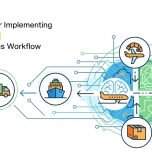We’ve covered considerable ground in this series – from understanding why AI red teaming is essential, to seeing how it works in practice, to exploring the attacker’s playbook, and finally to building your own strategy. But AI security isn’t a destination you reach and check off. It’s an ongoing journey that evolves as rapidly as the technology itself.
As we look toward the future of AI red teaming, one thing becomes clear: the organisations that treat security as a continuous practice rather than a project milestone will be the ones that thrive in an AI-driven world.
Why Red Teaming Matters More Than Ever
Let’s recap the fundamental reality driving everything we’ve discussed: AI systems are becoming deeply embedded in critical infrastructure, sensitive decision-making, and everyday interactions at unprecedented speed. The global cybersecurity market focused on red teaming and penetration testing is projected to reach $423.67 billion by 2032, reflecting the massive investment organisations are making in proactive security.
This growth isn’t hype – it’s a rational response to genuine risk. Every week brings news of new AI vulnerabilities, more sophisticated attacks, and expanding regulatory requirements. The organisations that discovered this early and built robust red teaming practices are now deploying AI confidently while others struggle with security concerns that slow their progress.
The stakes continue rising. As AI moves beyond generating text and images into controlling physical systems, managing financial transactions, and making consequential decisions about people’s lives, the cost of security failures escalates dramatically.
The Challenges That Won’t Go Away
Despite rapid progress in AI red teaming methodologies and tools, several fundamental challenges persist and will likely intensify as AI capabilities expand.
The Standardisation Problem
One of the most significant obstacles is the lack of universal standards for AI red teaming. Different organisations employ divergent approaches, making it difficult to compare results, establish industry benchmarks, or build on collective knowledge systematically.
While frameworks from organisations like CISA and NIST provide helpful guidance, they’re not comprehensive standards with widespread adoption. This fragmentation means organisations often reinvent approaches that others have already refined, wasting resources and missing opportunities to build on proven methodologies.
The good news is that standardisation efforts are accelerating. As regulatory requirements become more specific and the industry matures, we’re moving toward more consistent practices. Organisations that follow emerging frameworks position themselves ahead of future requirements.
Growing Complexity
Modern AI systems operate as “black boxes” with intricate architectures and opaque decision-making processes. Large language models contain billions of parameters trained on datasets so vast that fully understanding their behavior becomes practically impossible.
This complexity challenges red teams to test systems they cannot fully comprehend. How do you systematically probe for vulnerabilities in a system whose internal logic you cannot directly observe? Traditional debugging approaches don’t translate well to probabilistic AI systems that behave differently with slight input variations.
The complexity issue intensifies as AI systems become more sophisticated. Multimodal models processing text, images, audio, and video simultaneously create exponentially more complex attack surfaces than single-modality systems.
The Ever-Evolving Threat Landscape
Perhaps the most persistent challenge is that threats never stand still. As defenses improve against known attacks, adversaries develop new techniques. Data poisoning methods evolve. Novel jailbreaking approaches emerge. New vulnerabilities appear with each model architecture innovation.
This means red teaming cannot follow a static playbook. The attack strategies that work today may be blocked tomorrow, while entirely new vulnerability classes emerge. Red teams must continuously update their methods, staying ahead of adversaries who are simultaneously working to stay ahead of defenders.
The Talent Crisis
The shortage of skilled AI security professionals remains acute. The demand for experts who understand both AI systems and adversarial security far exceeds supply, and this gap is widening as AI adoption accelerates faster than workforce development.
This talent shortage drives organisations toward automated solutions and specialised partners – trends we expect to continue. The future likely involves more sophisticated automation handling routine testing while scarce human expertise focuses on novel vulnerabilities and strategic security decisions.
Emerging Focus Areas: Where Red Teaming Is Headed
As we look forward, several emerging areas will demand increasing attention from red teams.
Multimodal AI Systems
AI is rapidly moving beyond text-only interactions toward systems that seamlessly process and generate content across multiple modalities – text, images, audio, video, and even sensor data. These multimodal systems introduce vulnerabilities that don’t exist in single-modality AI.
Future red teaming must account for attacks that exploit interactions between modalities, hidden instructions embedded across different media types, and vulnerabilities that only emerge when multiple input types are processed simultaneously. The Microsoft discovery that image inputs were more vulnerable to jailbreaks than text was just the beginning.
Physical Security Considerations
As AI systems integrate with hardware and physical environments – autonomous vehicles, robotics, industrial control systems, smart infrastructure – physical security becomes crucial. An AI vulnerability isn’t just a data breach risk; it could enable physical tampering, hardware exploitation, or dangerous system behaviors in the physical world.
Physical red teaming, which tests for vulnerabilities in how AI-controlled physical systems can be compromised, represents an emerging discipline that combines traditional physical security with AI-specific testing.
Autonomous AI Agents
The next frontier involves AI systems that act autonomously – making decisions, using tools, and taking actions without constant human oversight. These autonomous agents raise entirely new security questions: How do you red team a system that learns and adapts continuously? What happens when AI agents interact with other AI systems? How do you prevent autonomous systems from being manipulated into harmful behaviors?
Red teaming autonomous AI requires methodologies that account for emergent behaviors, cascading failures across interconnected systems, and risks that only appear over extended operation periods.
The Regulatory Landscape: Compliance Becomes Mandatory
AI security is transitioning from best practice to legal requirement. The regulatory environment is evolving rapidly, with significant implications for red teaming practices.
The European Union’s AI Act requires operators of high-risk AI systems to demonstrate accuracy, robustness, and cybersecurity through rigorous testing. The US White House AI Executive Order mandates red teaming for high-risk AI systems, particularly advanced foundation models, with developers required to share safety test results with government agencies before deployment.
These aren’t isolated regulations – they represent a global trend toward mandatory AI safety testing. Organisations that invested in red teaming early for security reasons now find themselves ahead on compliance. Those who delayed face urgent pressure to implement testing programs quickly.
Future regulations will likely become more specific about testing methodologies, documentation requirements, and acceptable risk thresholds. The organisations that build mature red teaming practices now will adapt more easily as requirements tighten.
The Shift Toward Continuous Automated Red Teaming
Traditional security testing happens periodically – perhaps quarterly or before major releases. This approach worked reasonably well for stable software systems that changed slowly. It doesn’t work for AI systems that can be updated frequently, learn continuously, and face rapidly evolving threats.
The future of AI red teaming is continuous and increasingly automated. Rather than point-in-time assessments, organisations are implementing always-on security testing that continuously probes for vulnerabilities, monitors for emerging threats, validates that defenses remain effective, and provides real-time security posture visibility.
Automation makes this continuous testing practical and affordable. Advanced platforms can run thousands of attack scenarios daily, flagging issues for human review while building comprehensive security baselines over time.
However, automation complements rather than replaces human expertise. Sophisticated attacks still require creative human thinking to discover and validate. The optimal future involves automation handling comprehensive coverage of known vulnerabilities while human experts focus on discovering novel attack vectors.
Building Trust Through Transparency
As AI becomes more influential in consequential decisions, public trust becomes essential. Organisations that deploy AI in opaque ways, with no visibility into safety testing, face increasing skepticism from customers, regulators, and the public.
Red teaming provides the foundation for transparency. Organisations can demonstrate they’ve proactively tested their systems, identified and addressed vulnerabilities, and maintain ongoing security practices. This transparency builds trust that marketing claims alone cannot achieve.
We’re seeing leading organisations publish red teaming findings, share methodologies, and openly discuss discovered vulnerabilities and their remediation. This transparency might seem risky – admitting vulnerabilities exist – but it actually builds credibility by demonstrating commitment to safety over appearance.
The future likely involves more formalised transparency requirements: public reporting of red teaming results, third-party validation of security claims, and standardised security disclosures. Organisations that embrace transparency voluntarily will adapt more easily than those forced into it by regulation.
Red Teaming as Competitive Advantage and Ethical Imperative
Here’s the strategic reality: AI red teaming is simultaneously a competitive advantage and an ethical imperative. Organisations with mature red teaming practices can deploy AI faster and more confidently because they’ve systematically addressed security risks. They win customer trust through demonstrated safety. They avoid costly security incidents that damage reputation and disrupt operations.
But beyond competitive advantage, there’s an ethical dimension. Deploying AI systems that haven’t been rigorously tested for vulnerabilities exposes users to preventable harm. As AI makes increasingly consequential decisions, the ethical obligation to ensure safety intensifies.
The organisations that will define AI’s future aren’t necessarily those with the most advanced models – they’re those that can deploy AI safely, ethically, and at scale. Red teaming is how you get there.
Your Next Steps
If you’ve read through this series, you understand why AI red teaming matters, how it works, what attacks look like, and how to build your strategy. The question now is: what happens next?
For organisations just beginning their AI security journey, start with safety policies. Answer the two critical questions about your AI risks and acceptable behaviors. These foundations guide every subsequent decision.
For those with some security practices in place, evaluate whether your current approach matches your risk profile. Are you testing comprehensively enough? Do you account for emerging threats? Is your testing continuous or periodic?
For mature organisations, look toward the future. Are you prepared for multimodal vulnerabilities? Do you have plans for autonomous AI security? Are you building transparency into your practices?
Regardless of where you are in the journey, remember that AI red teaming is continuous practice, not a destination. The threats evolve, your AI systems evolve, and your security practices must evolve alongside them.
Partner with Aya Data for Future-Ready AI Security
At Aya Data, we don’t just help you address today’s AI security challenges – we prepare you for tomorrow’s. Our continuous security testing and automated red teaming approach ensures your AI systems remain secure as threats evolve and your capabilities expand.
We specialise in emerging areas like multimodal system testing, autonomous AI security, and integration vulnerability assessment. Our team stays current on the latest attack techniques, regulatory requirements, and industry best practices so you can focus on building great AI products rather than becoming security experts.
Whether you’re taking your first steps in AI red teaming or looking to mature existing practices, we provide the expertise, tools, and ongoing support to keep your AI systems secure across their entire lifecycle.
Ready to build AI systems that are secure, trustworthy, and future-ready? Contact us today to schedule a free consultation. We’ll assess your current AI security posture, discuss emerging risks specific to your use cases, and develop a roadmap for comprehensive red teaming that grows with your AI capabilities.
The future of AI is being built right now. Make sure you’re building it securely.






